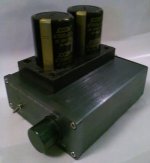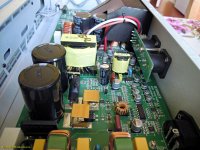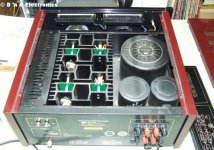Yup... But WOT said he's using 8R so he's getting about 18Hz already... I just usually strive to have the -3db point lower than that 🙂
How about... 19.9044585987Hz
Just some food for thought, the so called "roll off" has no definitive point, it starts at an infinitesimally high frequency for all RC filters (maybe there's physical limit to it which I am not aware of), I don't have the formula at my fingertips anymore as it has fallen out of my pipe brain long time ago but we could for a fun little exercise calculate what the frequency is, which is probably quite high, for let say 0.0001dB point, anyone feeling challenged? Let's go with 1000uF and 4Ohm.
Anyhow, when we start to look at 0.000...ndB point figures it's getting deep into the snakeoil territory because no matter what kind of distortion it has no practical value, except for those who want to sell on something insubstantial.
:)Just some food for thought, the so called "roll off" has no definitive point, it starts at an infinitesimally high frequency for all RC filters (maybe there's physical limit to it which I am not aware of), I don't have the formula at my fingertips anymore as it has fallen out of my pipe brain long time ago but we could for a fun little exercise calculate what the frequency is, which is probably quite high, for let say 0.0001dB point, anyone feeling challenged? Let's go with 1000uF and 4Ohm.
Anyhow, when we start to look at 0.000...ndB point figures it's getting deep into the snakeoil territory because no matter what kind of distortion it has no practical value, except for those who want to sell on something insubstantial.
The pole frequency is 3dB down, everyone has that committed to memory. But it’s useful to remember that an octave away is -1dB and 5X is 0.1 dB. Can you hear 0.1 dB down? Probably not even the phase shift associated with it. You hear THAT more than the 3dB down when you’re talking low (10-40 Hz) frequency.Idon't have the formula at my fingertips anymore as it has fallen out of my pipe brain long time ago but we could for a fun little exercise calculate what the frequency is
That part sounds interesting, a bit complicated to experiment with though on high cost hard to find "disposable" equipment, and even then, it won't fit in a cabinet with Power Supply SPMS. Although I think the same and also based on my experience........................
So some of the vintage amplifiers that are still popular (like the Krell) in spite of measuring like dogs compared to even big box AV receivers today have one virtue they don't have: beefy power supplies. That's why I say ditch the moldy old electronics, spruce up the power supply, reuse the heatsinks, and put modern electronics in there (like a Blameless clone with parallel outputs). It will never run out of current! Easy peasy and the best of both worlds.
I already reported in another post what happened when I compared the bass of a PA Crown vs. a "commercial" high-end power amplifier from Sansui. (from the same decade, 1970)
Solid bass on Crown, Phase Linear, etc.
"Flabby", "loose" bass in Sansui.
In a first analysis, we could assume that since they were the first designs of "super regulated and stabilized" sources, the Sansui slew rate was the culprit and that they have currently been more developed. Perhaps, I couldn't say for sure, since I haven't had any references to current 300 Watts Rms power amplifiers - integrated or not - with linear PWS.
I have also not been able to compare my current Bherinher -class D - of 450 Watts Rms - SMPS - in reverse.
However, having recently purchased a Pro Ject phono preamp equipped with an SMPS source, and reading on other forums that many users opt to replace it with a linear source and report better bass, I think the technical problem has not been overcome or is inherent to the low cost of switching current supplies vs. a linear source of equal voltage and intensity. In other words, low weight and cost win. It is logical, the cost analysts would not last even 24 hours. in their work if they insinuated going back to "the outdated".
About five years ago I had the opportunity to attend a musical show and in an interval I approached the sound operator, and seeing him unoccupied (respect for his work above all) I asked him about the power amplifiers he used. The answer was that they no longer have many of the "old school", when they are definitely irreparable and irreplaceable because they are no longer manufactured (is that right?) ) they have to replace them with modern class D, but they do not have a long life like the vintage ones, subjecting them to to the same demand".
Attachments
I wouldn't put a switcher in there, but you could. Krell power supply is its main virtue.
I've experimented plenty on old equipment. It costs nothing if you get it for free.
Heat sinks are big enough for anything you want to do.
The issue with bass is not switching vs linear but sagging of the power supply. More beef = less sag.
All the commercial "pro" amps I've seen lately are digital. More power, less heat. People still keep their old equipment running as long as possible, for good reason. What passes for musical sound reinforcement today isn't what it used to be. Everything is mixed down, compressed to death, amplified digitally, and reproduced through two speakers. Sometimes you can't even tell if the musicians are performing or miming. The good old days of the Grateful Dead Wall of Sound type live setup are gone I guess.
I've experimented plenty on old equipment. It costs nothing if you get it for free.
Heat sinks are big enough for anything you want to do.
The issue with bass is not switching vs linear but sagging of the power supply. More beef = less sag.
All the commercial "pro" amps I've seen lately are digital. More power, less heat. People still keep their old equipment running as long as possible, for good reason. What passes for musical sound reinforcement today isn't what it used to be. Everything is mixed down, compressed to death, amplified digitally, and reproduced through two speakers. Sometimes you can't even tell if the musicians are performing or miming. The good old days of the Grateful Dead Wall of Sound type live setup are gone I guess.
And Yes, I have cables with arrows since I've drawn them in order not to look behind cabinets.
Corner frequency is 3dB down in power, not voltage. Just for clarity sake 🙂
http://www.insula.com.au/physics/1221/L14.html
http://www.insula.com.au/physics/1221/L14.html
Attachments
Unless you're a pipe organ fanatic, anything lower than 25hz is noise.Yup... But WOT said he's using 8R so he's getting about 18Hz already... I just usually strive to have the -3db point lower than that 🙂
Like rumble, feedback, warped record speaker pumping, etc.
And who wants a system capable of feeding that garbage into the speakers?
And Phil Spector started that WOS idea ya know.I wouldn't put a switcher in there, but you could. Krell power supply is its main virtue.
I've experimented plenty on old equipment. It costs nothing if you get it for free.
Heat sinks are big enough for anything you want to do.
The issue with bass is not switching vs linear but sagging of the power supply. More beef = less sag.
All the commercial "pro" amps I've seen lately are digital. More power, less heat. People still keep their old equipment running as long as possible, for good reason. What passes for musical sound reinforcement today isn't what it used to be. Everything is mixed down, compressed to death, amplified digitally, and reproduced through two speakers. Sometimes you can't even tell if the musicians are performing or miming. The good old days of the Grateful Dead Wall of Sound type live setup are gone I guess.
I know about Phil Spector.
WOS meant the musicians heard the same thing the audience did. WOS means everything isn't mixed up into a mess of intermodulaltion distortion. WOS means full dynamics of the music was presented to the audience.
I think sound is secondary to music producers now. What's the point of attending a live musical performance when it sounds like an overcompressed, distorted reproduction? The musicians are so separated from the sound that you can't tell if they're miming or actually performing.
I've seen what passes for sound reinforcement now. Digital amplifier with 15" two way speakers. It's distorted and screechy.
WOS meant the musicians heard the same thing the audience did. WOS means everything isn't mixed up into a mess of intermodulaltion distortion. WOS means full dynamics of the music was presented to the audience.
I think sound is secondary to music producers now. What's the point of attending a live musical performance when it sounds like an overcompressed, distorted reproduction? The musicians are so separated from the sound that you can't tell if they're miming or actually performing.
I've seen what passes for sound reinforcement now. Digital amplifier with 15" two way speakers. It's distorted and screechy.
Yes there's a lot of boom and tinkle sound systems out there - made worse when they try and push LF out of the speakers that are just not up to it. I've been to some gigs of recent years where you have to wonder if the guy at the mixing desk is listening at all, or had just pressed "auto"....
Back in the day, Frank Zappa gigs had probably the best sound of all. They really cared.
Back in the day, Frank Zappa gigs had probably the best sound of all. They really cared.
Yessir! The ultimate live sound I ever heard in my life.Yes there's a lot of boom and tinkle sound systems out there - made worse when they try and push LF out of the speakers that are just not up to it. I've been to some gigs of recent years where you have to wonder if the guy at the mixing desk is listening at all, or had just pressed "auto"....
Back in the day, Frank Zappa gigs had probably the best sound of all. They really cared.
The good sound guys had confederates sitting out in the audience with 2-way radios giving feedback on S.Q. to the sound man.
Absolutely. When I was at Concord Pavilion they tried a couple of wired up dummy heads in the audience to help the sound guys.
A lot of snake oil is about trying to sell people something they don't need.
Classic is the latest PC processor which is much much faster.
When you look into it its about 10% quicker which is pitiful.
I recently upgraded from Intel 8th gen to 12th gen processor, difference over the 4 gens was 30%.
Could I feel or see the difference generally, well no.
Luckily I got 2/3 of the cost of the new cpu back on the old one on ebay.
Classic is the latest PC processor which is much much faster.
When you look into it its about 10% quicker which is pitiful.
I recently upgraded from Intel 8th gen to 12th gen processor, difference over the 4 gens was 30%.
Could I feel or see the difference generally, well no.
Luckily I got 2/3 of the cost of the new cpu back on the old one on ebay.
Do you mean it is like upgrading a speaker cable to another that is 10% better? And selling your old special cryogenically treated directional hand-made high-end cable for 2/3 of the cost of the new cable?A lot of snake oil is about trying to sell people something they don't need.
Classic is the latest PC processor which is much much faster.
When you look into it its about 10% quicker which is pitiful.
I recently upgraded from Intel 8th gen to 12th gen processor, difference over the 4 gens was 30%.
Could I feel or see the difference generally, well no.
Luckily I got 2/3 of the cost of the new cpu back on the old one on ebay.
- Status
- Not open for further replies.
- Home
- Member Areas
- The Lounge
- Funniest snake oil theories



